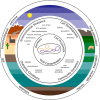Lysogeny in nature: mechanisms, impact and ecology of temperate phages
- PMID: 28291233
- PMCID: PMC5520141
- DOI: 10.1038/ismej.2017.16
Lysogeny in nature: mechanisms, impact and ecology of temperate phages
Abstract
Viruses that infect bacteria (phages) can influence bacterial community dynamics, bacterial genome evolution and ecosystem biogeochemistry. These influences differ depending on whether phages establish lytic, chronic or lysogenic infections. Although the first two produce virion progeny, with lytic infections resulting in cell destruction, phages undergoing lysogenic infections replicate with cells without producing virions. The impacts of lysogeny are numerous and well-studied at the cellular level, but ecosystem-level consequences remain underexplored compared to those of lytic infections. Here, we review lysogeny from molecular mechanisms to ecological patterns to emerging approaches of investigation. Our goal is to highlight both its diversity and importance in complex communities. Altogether, using a combined viral ecology toolkit that is applied across broad model systems and environments will help us understand more of the diverse lifestyles and ecological impacts of lysogens in nature.
Conflict of interest statement
The authors declare no conflict of interest.
Figures



References
-
- Abedon ST. (2009). Disambiguating bacteriophage pseudolysogeny: an historical analysis of pseudolysogeny, and the phage carrier state. In: Adams HT (ed). Contemporary Trends in Bacteriophage Research. Nova Science Publishers: New York, NY, USA.
-
- Alivisatos AP, Blaser MJ, Brodie EL, Chun M, Dangl JL, Donohue TJ et al. (2015). MICROBIOME. A unified initiative to harness Earth's microbiomes. Science 350: 507. - PubMed
MeSH terms
LinkOut - more resources
Full Text Sources
Other Literature Sources

